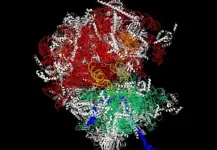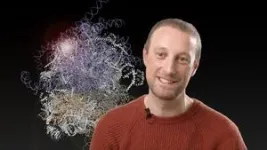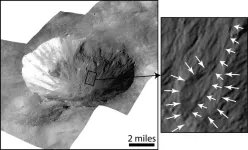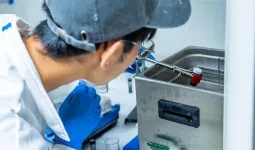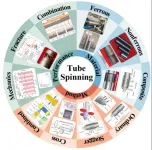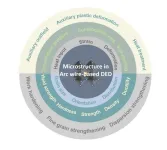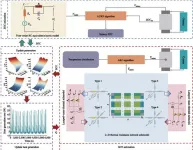(Press-News.org) STALKING RIBOSOMES: HOW CANCER CELLS PULL POKER FACES
The protein factories of our cells are much more diverse than we thought they were. Scientists from the Netherlands Cancer Institute have now shown that cancer cells can use these so-called ribosomes to boost their invisibility cloak, helping them hide from the immune system. The team publishes their findings in Cell today. “These findings make us change how we think about ribosomes.”
Our immune system is constantly monitoring our body. In order to survive, cancer cells need to evade this inspection. “Making cells more visible to the immune system has revolutionized treatment”, says researcher Liam Faller from the Netherlands Cancer Institute. “However, many patients don’t respond to these immunotherapies or become resistant.” How cancer cells manage to circumvent elimination by the immune system is still a million dollar question though.
Turns out cancer cells might use our very own protein factories to hide. Each of our cells contain a million of these minuscule factories, called ribosomes. Liam: “They make all the protein we need. This job is so essential: all life depends on it! This is why people have always thought that every ribosome is the same, and that they just passively churn out protein as dictated by the cell’s nucleus. We’ve now shown that this is not necessarily the case.”
Cells change their ribosomes when they receive a danger signal from the immune system, the new study showed. Liam: “They change the balance towards a type of ribosome that has a flexible arm sticking out, called a P-stalk. In doing so, they become better at showing themselves to the immune system.”
Just like the look on someone’s face, the surface of a cell gives away a lot about what is happening on the inside. “Cells coat themselves with little chunks of protein, which is how our immune system can recognize them and tell when there is something wrong”, Liam explains. “This is an essential part of our immune response. If a cancer cell can block this, it can become invisible to the immune system.”
Liam’s group has now uncovered a new way in which cancer cells could pull such a poker face: by affecting their ribosomes. Less flexible-arm-ribosomes, means less ‘emotions’ on their (sur)face. “We are now trying to figure out exactly how they go about this, so we can maybe block this ability”, says Anna Dopler, member of Liam’s group and closely involved in the project “This would make cancer cells more visible, enabling the immune system to detect and destroy them.”
New angles for future cancer therapies aside, Liam is fascinated by ribosomes: “Every single cell that has ever existed in our family tree relied on ribosomes. There is a hypothesis that all of life developed to allow the ribosome duplicate itself. It’s a pretty wild idea, but I love it! I have no idea whether it is true, but just the simple fact that there is something that ancient in every one of our cells fills me with awe.”
This research was financially supported by NWO Dutch Research Council, The Mark Foundation and KWF Dutch Cancer Society.
The Netherlands Cancer Institute
The Netherlands Cancer Institute (www.nki.nl) is among the world’s foremost comprehensive cancer centers, combining innovative fundamental, translational, and clinical research with dedicated patient care. In our research institute, around 750 researchers from 45 countries work towards solving the mysteries of health and disease and improving the prospects of cancer patients. We gratefully acknowledge funding from the Dutch Ministry of Health, Welfare and Sport, the Dutch Cancer Society, and individual donors.
END
Stalking ribosomes: How cancer cells pull poker faces
Cancer cells might use our very own protein factories to hide for immune system
2024-10-21
ELSE PRESS RELEASES FROM THIS DATE:
At-home brain stimulation for depression is safe and effective, according to research from UTHealth Houston, King’s College London, and University of East London
2024-10-21
A device that delivers direct stimulation to the brain was found to be a safe and effective means of treating depression at home, according to a new study by researchers at UTHealth Houston; the Institute of Psychiatry, Psychology & Neuroscience at King’s College London; and the University of East London.
The research was published in Nature Medicine on Oct. 21, 2024.
Transcranial direct current stimulation (tDCS) is a form of noninvasive brain stimulation that applies a weak, direct current of between 0.5 to 2 milliampere to the scalp via two electrodes. It is already commonly used in clinics to treat conditions such as psychosis ...
A 37% drop in overdose deaths from drugs mixed with opioids – fentanyl included
2024-10-21
COLUMBUS, Ohio – Expanded treatment options, increased naloxone distribution and targeted education campaigns likely led to a 37% reduction in overdose deaths from opioids combined with stimulant drugs other than cocaine, according to the results of a large federally funded study.
The finding came from a planned study of secondary outcomes of the HEALing (Helping to End Addiction Long-Term) Communities Study (HCS), which tested an intervention encompassing data-driven adoption of evidence-based practices for reducing overdose deaths in Kentucky, Massachusetts, New York and Ohio.
Death rates from specific combinations of ...
Research spotlight: Investigating strategies to help clinicians and patients navigate prescription costs
2024-10-21
Hussain S. Lalani, MD, MPH, MSc, of the Division of Pharmacoepidemiology and Pharmacoeconomics at Brigham and Women’s Hospital, is the lead author of a paper published in JAMA, “Strategies to Help Patients Navigate High Prescription Drug Costs.”
How would you summarize your study for a lay audience?
Prescription drugs can be expensive for patients, and many clinicians do not know how to respond when costs are too high. We reviewed the benefits and limitations of seven strategies that clinicians can use to help their patients navigate high-prescription drugs. These include co-payment cards, patient assistance ...
Betelgeuse Betelgeuse? Bright star Betelgeuse likely has a ‘Betelbuddy’ stellar companion
2024-10-21
The 10th-brightest star in the night sky, Betelgeuse, may not be on the brink of exploding as a supernova, according to a new study of the star’s brightening and dimming. Instead, recent research shows that the observed pulsing of the starlight is probably caused by an unseen companion star orbiting Betelgeuse.
Formally named Alpha Ori B, the “Betelbuddy” (as astrophysicist Jared Goldberg calls it) acts like a snowplow as it orbits Betelgeuse, pushing light-blocking dust out of the way and temporarily making Betelgeuse seem brighter. Goldberg and his colleagues present their simulations of this process in ...
SwRI and JPL co-led study offers insights into mysterious features on airless worlds
2024-10-21
SAN ANTONIO — October 21, 2024—A Southwest Research Institute researcher collaborated with a team at NASA’s Jet Propulsion Laboratory to attempt to explain the presence of mysterious flow features that exist on the surfaces of airless celestial bodies, such as the asteroids Vesta and Ceres, explored recently by the NASA Dawn mission, or Jupiter’s moon Europa, which will soon be explored in detail by the NASA Europa Clipper mission that includes SwRI’s involvement.
In a new paper published in The Planetary Science Journal, its lead author, SwRI’s Dr. Michael J. Poston, and a team of researchers outline how post-impact conditions, ...
Artificial ‘nose’ can sniff out damaged fruit and spoiled meat
2024-10-21
Although smell has historically played an important role in the fight against diseases such as the plague and tuberculosis, the human nose is generally not sensitive enough to be used as a reliable diagnostic tool.
However, a new artificial ‘nose’ inspired by our sense of smell could now make it possible to detect undiagnosed disease, hazardous gases, and food that is starting to spoil.
And it is all made possible with technology that already exists.
Surrounded by antennas
What do your mobile phone, computer and TV have in common? Antennas.
“We are literally surrounded by technology that communicates using antenna technology,” said Michael ...
Tube spinning process: Recent advances and challenges
2024-10-21
Amidst the sustainable evolution of the economy and society, the issues of energy scarcity and environmental degradation have gained increasing prominence, making energy conservation and emission reduction the focal point of societal concern. Within this context, metal tubes fittings, as essential components, wield significant and extensive influence in domains such as aviation, aerospace, and new energy vehicles. Notably, the burgeoning prominence of advanced plastic forming methods, epitomized by the flexible medium forming process of tubes, has garnered ...
Enhancement of material microstructure and properties in Arc wire-based direct energy deposition: A short review
2024-10-21
In recent years, additive manufacturing technology has attracted considerable attention from various stakeholders. Among the different techniques, Arc wire-based direct energy deposition (DED) has experienced a notable increase in development, offering compelling advantages such as cost-effectiveness and high forming efficiency. However, a high deposition rate results in extremely high heat input and temperature inhomogeneity, leading to a deterioration in surface quality, a reduction in material properties, an increase in residual stresses and even distortion and cracking. Consequently, the current research agenda is focused on developing methods to ensure the quality ...
Cloud computing captures chemistry code
2024-10-21
RICHLAND, Wash.—Some computing challenges are so big that it’s necessary to go all in. That’s the approach a diverse team of scientists and computing experts led by the Department of Energy’s Pacific Northwest National Laboratory, along with colleagues from Microsoft and other national laboratories and universities, are taking to democratize access to emerging cloud computing resources.
The effort, outlined in a recent peer-reviewed journal publication, provides a road map to moving scientific computing resources into a sustainable ecosystem that evolves as ...
Novel electrothermal model enables co-estimation of SOC and SOT
2024-10-21
For the main energy storage system for EVs, Li-ion batteries are extensively applied owing to their excellent overall performance The safe and efficient operation of the electric vehicle significantly depends on the accurate state-of-charge (SOC) and state-of-temperature (SOT) of Lithium-ion (Li-ion) batteries. A recent breakthrough study presented by researchers from the Tongji University and Chongqing University introduces a co-estimation of state-of-charge and state-of-temperature for large-format lithium-ion batteries based on ...
LAST 30 PRESS RELEASES:
Deep neural networks enable accurate pricing of American options under stochastic volatility
Collective risk resonance in Chinese stock sectors uncovered through higher-order network analysis
Does CPU impact systemic risk contributions of Chinese sectors? Evidence from mixed frequency methods with asymmetric tail long memory
General intelligence framework to predict virus adaptation based on a genome language model
Antibiotic resistance is ancient, ecological, and deeply connected to human activity, new review shows
Vapes, pouches, heated tobacco, shisha, cigarettes: nicotine in all forms is toxic to the heart and blood vessels
From powder to planet: University of Modena engineers forge a low-carbon future for advanced metal manufacturing
Super strain-resistant superconductors
Pre-school health programme does not improve children’s diet or physical activity, prompting call for policy changes, study finds
Autumn clock change linked to reduction in certain health conditions
AI images of doctors can exaggerate and reinforce existing stereotypes
Where medicine meets melody – how lullabies help babies and parents in intensive care
We may never be able to tell if AI becomes conscious, argues philosopher
AI video translation shows promise but humans still hold the edge
Deep ocean earthquakes drive Southern Ocean’s massive phytoplankton blooms, study finds
Without campus leftovers to pick through, the beaks of this bird changed shape during the pandemic
High-dose antibiotic does not reduce mortality in tuberculous meningitis
How many insects fly in the sky above the USA?
Could cheese protect your brain health?
Who faces more difficulty recovering from stroke?
Colliding galaxies create the brightest, fastest growing black holes at their center
New BrainHealth research reveals tradeoffs on sleep with cannabis use for chronic pain
Aging-US now on ResearchGate, enhancing visibility for authors and readers
'Molecular glue' stabilizes protein that inhibits development of non-small cell lung cancer
Mount Sinai Health System is recognized in 2025 Chime Digital Health Most Wired survey
From prey to predator: How carnivores spread beneficial fungi
Menopause symptoms may be frequent and have negative effects, according to female endurance athletes
US Congressmembers’ responses on X to mass shooting events differ along party lines
KAIST-UEL team develops “origami” airless wheel to explore lunar caves
Individual genetic differences render some therapies ineffective
[Press-News.org] Stalking ribosomes: How cancer cells pull poker facesCancer cells might use our very own protein factories to hide for immune system
